Strawberry plants are a wonderful forb. Their life cycle is much more complicated than the simple appearance of the humble strawberry plant implies. The growth cycle of strawberry plants spans the entire year and repeats annually. The life cycle of strawberry plants begins either from seed or from runner plants, and continues until senescence. This post is an overview of the life of a strawberry plant from germination until withered, brown leaves signify the passage from life unto death.
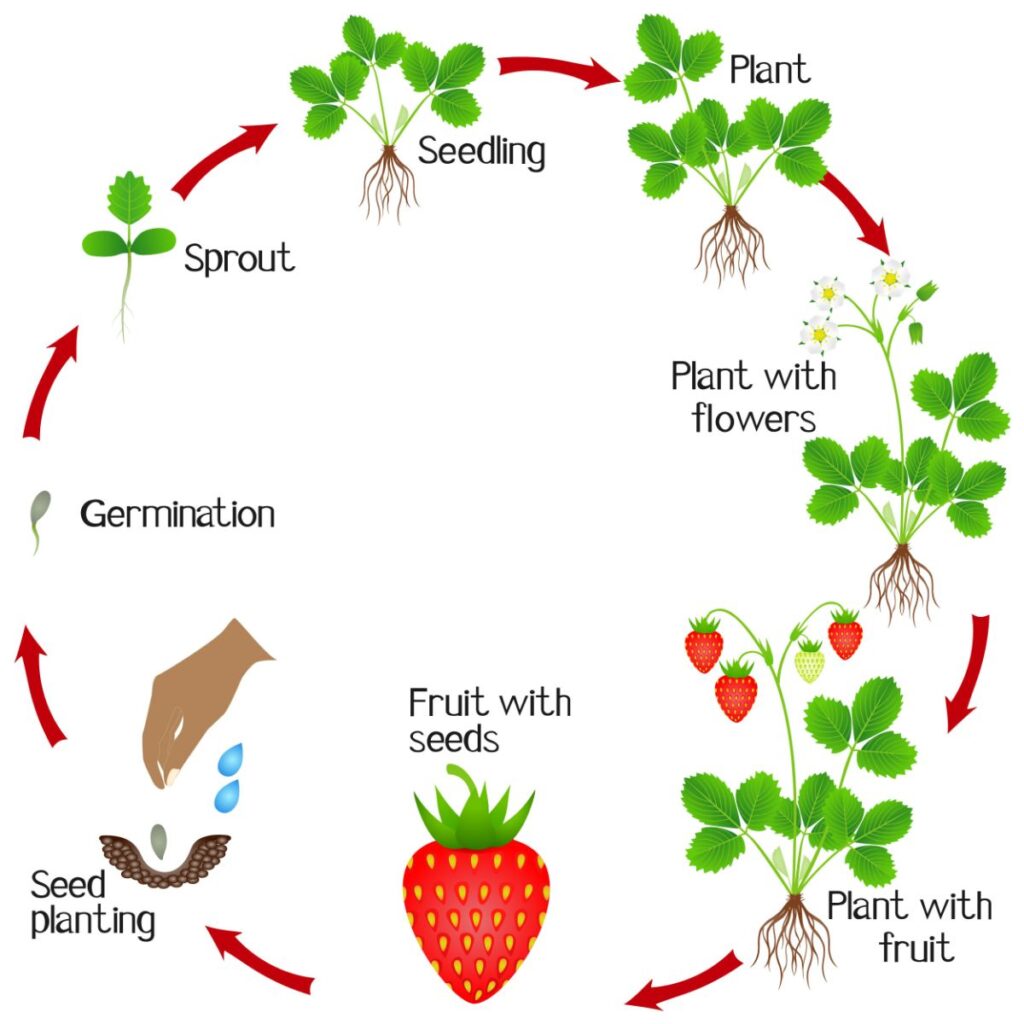
The Growth Cycle of Strawberry Plants
As with any cyclical scenario, it is difficult to choose a starting point (which came first, the chicken or the egg?). For the purposes of describing the life cycle of strawberry plants, a dual starting point will be considered as a sprouted strawberry seedling and a new strawberry runner. While both of these starting points require the existence of prior life, a discussion of the origins of life is outside the purview of this article.
Life Cycle of Strawberries: Beginnings
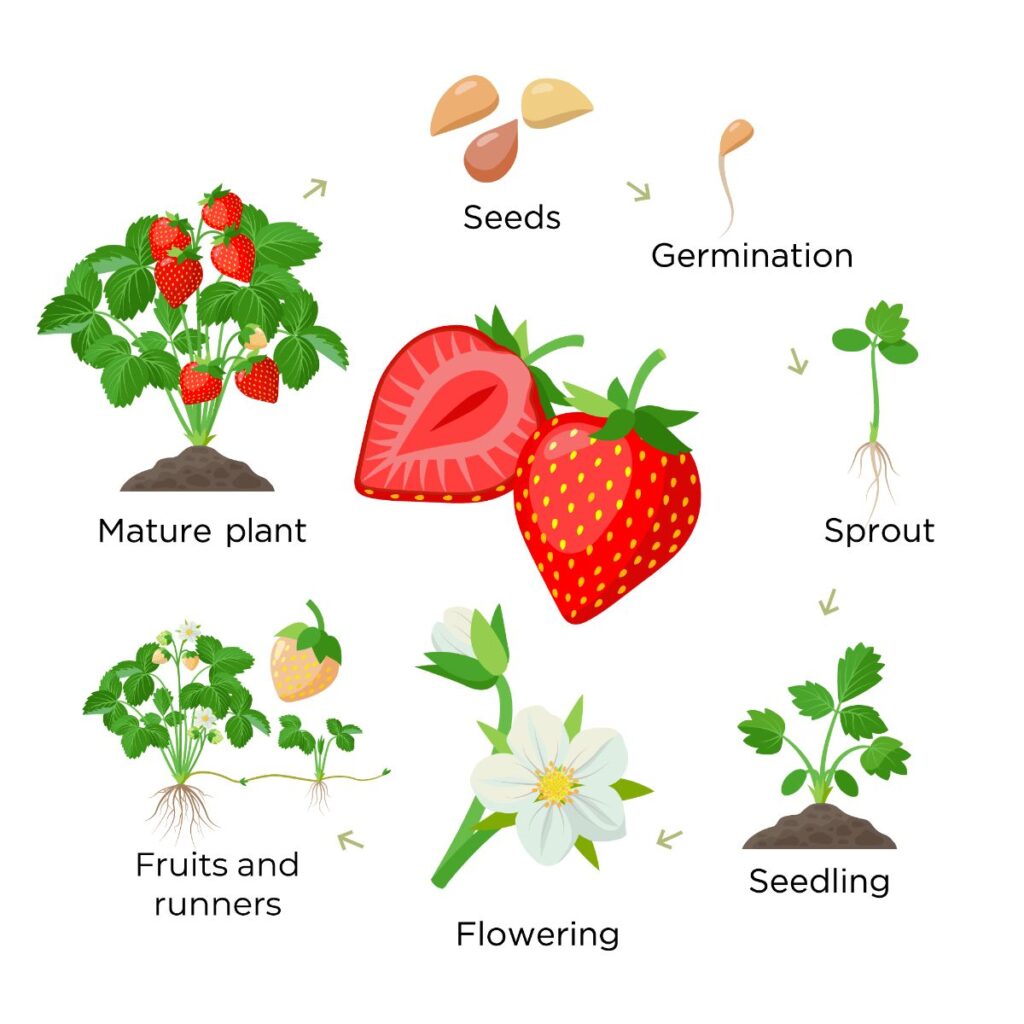
The strawberry seed, as with all seeds, contains the genetic material necessary for the continuation of the plant species (see the Strawberry Seeds page for more details). Upon sprouting, the roots are sent downward into the soil, and the transformation of nutrients into plant matter proceeds as the life cycle of the plant is perpetuated by resources obtained from the plants surroundings. These seedlings are genetically varied from the parent plants. Alternatively, established strawberry plants multiply themselves by means of clone or daughter plants extended from themselves by means of stolons to root some distance away from the mother plant and be established as an independent, but genetically identical, strawberry plant (see this page for more details: Strawberry Runners). Strawberry seeds will usually sprout in the late winter or spring after a period of cold stratification during winter months (but this isn’t required for all strawberry varieties) while runner plants are generally established later in the spring through the fall during warmer temperatures.
Jump to:
- The Growth Cycle of Strawberry Plants
- Life Cycle of Strawberries: Beginnings
- Growth Cycle of Strawberry Plants: Maturation
- Growth Cycle of Strawberries: Multiplication & Expansion
- Life Cycle of Strawberry Plants: Seeds
- Life Cycle of Strawberries: Life Span
- How Strawberry Plant Reproduce Themselves
- Life Cycle of Strawberry Plants: Conclusion
Growth Cycle of Strawberry Plants: Maturation
Once root growth commences, plant growth begins in earnest for both seedlings and runner plants. This allows all parts of the strawberry plant to grow and mature. The runner plants have a distinct advantage over seedlings. They start out larger and have a more fully formed support system providing the energy needed for development. But, by the time late summer and early fall rolls around, both seedlings and runner plants are usually established. In the process of growing, the plants will have sent forth roots and produced a canopy of photosynthesizing tri-lobed leaflets sitting atop non-woody stems. Both roots and leaves extend from the hub of the strawberry plant, the crown.
Growth Cycle of Strawberries: Multiplication & Expansion
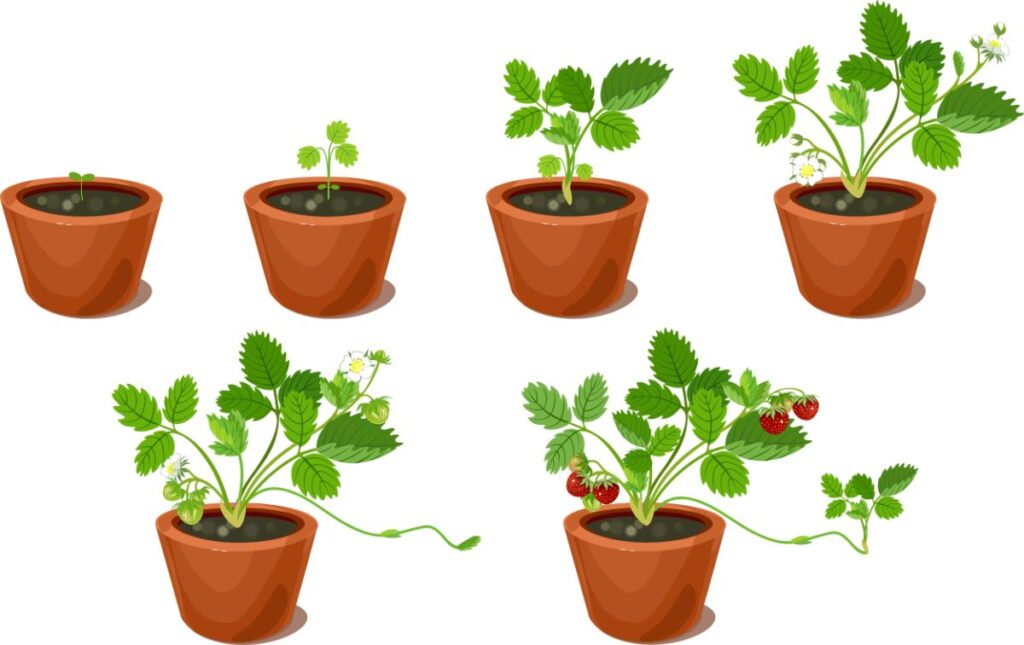
Once the plants have matured, they are ready to multiply and expand. They do this by means of the runner plants that have already been mentioned. The runners (stolons) are usually between 8 and 18 inches long, depending on the strawberry variety. These extensions serve to spread a strawberry plant’s range and find areas more favorable to growth, whether through higher soil quality or increased exposure to sunlight. Most strawberry varieties are adept at multiplication in this fashion, and they are even considered an invasive weed in some situations.
Life Cycle of Strawberry Plants: Seeds
While strawberry plants produce runners, they don’t put all their reproductive eggs in the same basket. Each strawberry plant devotes significant energy to genetic diversification through seed production. Strawberry seeds come from strawberry flowers which come from strawberry buds which are formed in the crowns of established strawberry plants. There are some variances of flower bud, flower, and strawberry production depending on which type of strawberry plant is considered (see the Strawberry Variety page for more details). The most common of these types is the June-bearing strawberry, and it will be considered here.
During the late summer and early fall, strawberry plants begin forming flower buds within their crowns. During this period, adequate water, light, and nutrients are critical. The flower buds form prior to winter and then move into dormancy (along with the rest of the plant) as the temperature drops. When temperatures again warm in late winter or early spring, the plants revive and immediately begin the transformation of the flower buds into flowers sitting atop stalks. These flowers, like most flowers, are then pollinated by insects and other pollinators. The result of pollination is a large mass of (usually red) accessory tissue studded with individual seed-containing fruits (there are also white strawberries, however). These achenes are attractive to birds and other creatures (including humans!) and are eaten. They are then digested. The remains, including many viable seeds, are then deposited in different locations to sprout and begin the life cycle of strawberry plants again.
Life Cycle of Strawberries: Life Span
The life arc of strawberries begins with the establishment of a new plant, peaks two to three years later, and then proceeds toward senescence and death two to three years following its peak. Under ideal conditions, a strawberry plant can live up to 5-6 years. After 3 productive years, however, they usually begin to lose vigor, and the production of strawberries begins to decline rapidly. Eventually, as age progresses and the strawberry plant weakens, strawberries usually succumb to ubiquitous opportunistic fungi or other environmental pathogens. The death process usually commences with spots, defects, and browning of previously healthy plant tissues and ends with a brown, withered, decomposing mass.
How Strawberry Plant Reproduce Themselves
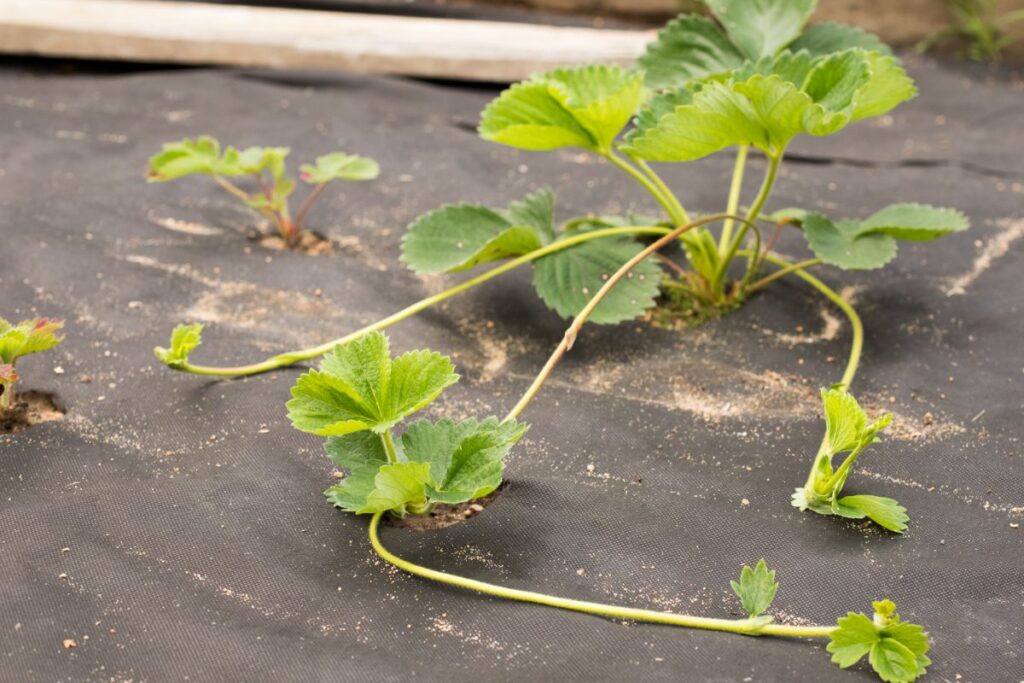
Strawberry plants are perennials. They can reproduce by seed. Home gardeners find growing strawberry plants from seed notoriously difficult.
Strawberry plants also grow by runners. Runners are long stems with leaves that can develop their own root system where they touch moist soil.
A runner is the same plant as its parent until it is no longer connected to the crown, the central mass of roots of the strawberry plant. But even after the runner is cut off and transplanted somewhere else, it remains a clone of the mother plant. It is just a younger version of the strawberry plant you have been growing for one, two, three, or more years.
Strawberry plants grow runners late in the season.
Strawberry plants don’t put their energy into producing runners until after they have produced fruit. After the plant has produced strawberries with their tiny seeds and as summer days begin to wane, a strawberry plant senses it is time to put out runners.
There is a beginning and an end to “runner season” for strawberry plants. Summer-bearing strawberry plants put all of their energy into producing fruit as the days are getting longer. Strawberries are coated with tiny seeds that can reproduce the plant, and, in nature, red, sweet strawberries encourage animals to spread strawberry seeds far and wide.
After producing fruit, the plant devotes its energy into producing runners. Long days trigger the production of a hormone called gibberellin that causes stems to grow longer. (You can buy gibberellin to force strawberry plants to grow long stems, but you don’t need to, because the strawberry plants will do this on their own.) After producing fruit, the plant’s energy is focused on making runners.
Scientists have discovered that the strawberry plant has to finish producing its runners before temperatures average about 10 degrees Celsius (52 degrees Fahrenheit). Cool and cold weather cause the plant to go dormant. Dormant strawberry plants have to survive on stored energy through the winter until next spring.
Life Cycle of Strawberry Plants: Conclusion
Throughout their life, strawberry plants provide many times their own weight in harvested strawberries. They are one of the most productive plants when what is produced from the weight of the plant is considered. Strawberries begin to ripen four to five weeks after the first flowers open and continue to ripen for about three weeks. Have you considered growing strawberries yourself this year? If so, there are a host of suppliers from which you can find multiple strawberry varieties for sale. Simply see this directory: Strawberry Plants for Sale.
Understanding the growth cycle of strawberry plants can help you in your strawberry growing endeavors. Good luck!


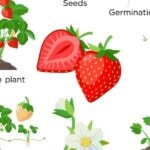







Lauren says
Hello there! I have June bearing strawberries. The original plants are several years old and produce numerous runners and blooms every spring. However, I do not get any berries. This has happened for the last three years. The soil is a nice compost and there is plenty of water but not too much. The plants themselves are beautiful and bountiful but there is no fruit. Are the plants themselves too old and need to be replaced? Or am I doing something wrong?
Thank you,
Lauren
Mary Ward says
It does sound like some renovation and perhaps replacement (or at least supplementation) is in order. One other thing to be aware of is, are they getting pollinated? Also, if your blossoms get hit with frost they won’t fruit so if you have frosts after your plants are in bloom, they should be covered.
Given the age of the patch, it’s likely time to replace them.
anthony says
hi I was asking if you can grow strawberries in winter
Mary Ward says
Yes. Not sure where you live, so outdoors might be possible but they can be grown indoors, too. It would require quite a bit in a lighting setup, though.
Bill Arnol says
Hi
I have grown hydroponic strawberries for a number of years now with good success but this year early in the season mostly all I am getting is runners and very few strawberries.
The runners usually come late in the season but not this year.
How can I change this problem?
They are very healthy looking plants.
Mary Ward says
It may be time to separate some runners and start some fresh plants, or reinvigorate your setup by adding some new plants. Also, make sure the temperature is not too high, which can result in few or no berries.
Toto says
How many months does the strawberry plants start to bear fruits?
Gary says
I planted ever bearing strawberry plants last Spring(2020)in a raised bed. They grew very well and I removed all blossoms during the season. I covered them with 4-6 inches of weed free straw for the winter(I live in SE South Dakota) This Spring(now May 2nd)I am seeing no greening up. Did something go wrong?
Don Cordier says
Buy home depot berrys I planted mine 12 years back they’ve been buried in 6ft of snow without covering them pulling just add some miracle grow and leave them alone and dont plant in boxes
MJ says
Hello, i am currently planting 2 varieties in my hydroponics system ( San Andreas and Portola), the plants have been planted no more that 3 weeks ago. The Portola variety started producing flowers about 1 week after planting with a lot of vigour while the San Andreas variety is growing quite well with leaves reaching 15 cm of height and some have flowers. After planting by a couple of the weather got cold reaching 20 degrees Celsius by day and 12 degrees at night. I am currently removing flowers from all the plants just kept a few plants with some flowers to see what will happen to them. Some of the plants have calcium deficiency which we fixed by increasing calcium to the tanks. My question is do i keep on removing flower for the next 2 to 3 weeks or should i leave them. Approximately how much time does the flower need to become a strawberry ? Most of the flowers are opening what should i do ?
Rosebud says
Remove all flowers the first year in order for the plants to gain enough strength for production in the future — that’s the rule for in ground but not sure about hydroponics. Do you plan on replacing every year?
Don Cordier says
Hello might I suggest something.I live in the high desert of northern Nevada my strawberries have been in the ground close to 12 years and produce lots of berrys I just add some miracle grow and leave them alone
Heidi McCann says
Hello!
I’m a Southern California container gardener, and back in September I rooted runners in a pot that established very nicely. We are now at the beginning of February and the plants are producing bunches of strawberries anywhere from 5-7. While I’m happy to see this, I’m also concerned about the time of the year, and with it being “cold for California” at this time, how will it affect the flavor and size potentially growing in an “off-season”? Should I pinch the blooms off to allow them to mature more, and start fertilizing them in a few weeks with Spring coming? Also, is it typical for newly established runner plants to begin producing so many berries?
Thanks in advance!
Heidi
Rosebud says
First year plans are always pinched of all flowers… or their future strength for production is considerably lessened. If you are replacing every year well maybe that doesn’t matter but from years of growing — VA we give them 1 year to establish and produce berries the 2nd year (from spring or fall initial planting) ie their 2nd spring in the ground. If you make a triple bed, you can train the first year runners to one side and the next year to the opposite side. On the 3rd or 4th year depending on how they are bearing, you till or pull up the middle mother plants. Don’t forget to cut them off from the daughters first or you will have a mess. By the 4th year the daughters should be well established if you have been feeding (Established plants I use slow acting Espoma Tomato Organic granular – it has plenty of calcium for them in form of gypsum along with kelp and alfalfa meal, and other good stuff. Check the Espoma website. ) The first year of planting I feed Stark Bros. strawberry water soluble food (10-52-17) every 7-14 days as directed. When the planting beds are prepared I add in the applicable amount of the Espoma to the native soil or the potting soil if planting in planters. All flowers are pinched – this is a job the first year but it is worth it for keeping plants going for 5-6 yrs and even longer. They need to be strong enough to keep on producing berries and runners. If you have another location you can prepare, you can take up daughters after they have established and move them to another triple bed as described and let the mothers keep producing as long as they are strong and healthy. Once they start getting diseased, you need to abandon those beds. It will happen. Commercial growers steam sanitize or gas their beds with chemical to kill diseases and pests. Check out “commercial production of strawberries”. Guides done by Univ. of Cornell, Idaho, LA, etc. Look for a guide by your own state university if you can – if not check the one closest to you.
Chaitanya says
Do we require a mother plant to produce runners. (OR) any strawberry plant can produce runners.
Kathy says
I have been growing ever-bearing strawberries in pots and every winter, I put them in the ground. In the spring I dig them up, cut the plants into two to three separate plants and put them back into pots. It has worked well and they have produced large strawberries. Since I have been purchasing new soil every year(mine is sand), I had a bed put in this year to create a permanent home for them. I have 18 plants now and the original is about 4 years old now. They look healthy and are still producing a lot of strawberries and taste great, but they are tiny. Is this what happens when a plant gets too old or could they be unhappy with the new soil? I did transplant them a little later than usual as I waited for the bed to be completed.
Christine J Pollastro says
I also have ever-bearing berries that I finally planted into a bed. I find, the only thing that determines size seems to be how much water they get. So I’d give it time, and let them keep rooting before you expect too much from them. But wow, get excited!
Heather says
I am planting 2500 surecrop strawberries here in Virginia this year, Southwest Virginia. Surecrop are June producers and I got them so they would produce a couple years. So what type of mulch would be best. I wanted the plastic mulch but will the strawberry be able to produce through the plastic?
Jeff says
I don’t know what plastic mulch is, but the best mulch would be straw. I put a layer of straw around my plants, probable 3-4 inches deep. It helps keep the soil moist and it protects the berries from getting dirty. I had an incredible season, with over 90 plants in my raised bed, sub-irrigated garden, with 2 water drippers on each plant. I didn’t have to water, I just had to keep weeding and taking out dead or wilted leaves. Good luck, and I would seriously get some straw, you can get some at a FEED store.
Running Moms says
My question is….my plants produced an adunfance of strawberries for about 4-6 weeks. The plants seem to be slowing down and some of the leaves dying. Is there anything I should do or can do to get the plants to keep producing or is the berry season over. We live in Montana and it’s been very hot and Sunny!! Thank you!
Mr. Strawberry says
Running Moms,
It sounds like your plants are likely June-bearing strawberries. If so, exactly what you described is completely normal! For June-bearers, the season is likely over. You may get onesies and twosies for the rest of the year, but they won’t produce a heavy crop again until next spring. Good luck!
kd faacks says
What time of year are plants dug for commercial sale?
Mr. Strawberry says
kd faacks,
The nurseries that produce plants for resale have several different methods of growing plants for resale. Many will utilize clonal propagation from tissue culture (like Nourse Farm) or crown separation. Runner propagation is also utilized to make plug plant trays that are then sold. The growing mainly occurs during the summer and fall with dormancy occurring prior to shipment. Since dormancy is variable by region and can be artificially induced, commercial sales are only limited by the amount of stock and the storage facilities on hand. Hope that helps!
kd faacks says
I have a big field bindweed problem in my large strawberry patch. I have renovated it several times but have been unable to eliminate the bindweed. I live in Weiser, Id and would like to mow my plants when they go dormant this fall, harvest plants and use roundup to exterminate the patch. What do I have to do to maintain my harvested plants until Spring. or should they be replanted before winter?
Mr. Strawberry says
kd faacks,
It is better to transplant them in the fall prior to dormancy. Late September is a great time to transplant. If you want to move your plants to a new location, this might help. Good luck!
Tak says
My question is, does a strawberry continue to grow after it ripens/red. First time grower (albion variety,) have several berries growing now, but I don’t know if I should pick them? They are bright red already, but still pretty small (size of quarter). Help please.
Mr. Strawberry says
Tak,
No, the berries don’t continue to grow once they are red and ripe. Go ahead and pick and enjoy them! Good luck!
Brad says
Here’s something that may be a bit of a unique situation. I live in an area of temperature extremes. During the summer months, temperatures warmer than 25 degrees Celsius are fairly common, and our winters can be extremely cold(I saw the mercury fall below -30 degrees Celsius repeatedly this past year). I’m looking at an experimental hydroponic setup. Being above ground, without soil around to insulate them, and no reasonable way to run water outdoors during the winter, I imagine plants will die off at a fairly quick rate. So I’m wondering about putting them on racks in the garage with some grow lights. Should the temperature be kept lower and the photoperiod shorter to trigger some kind of an off-season rest cycle for the plants, or will they continue to produce normally if maintained in more “summery” conditions?
Mr. Strawberry says
Brad,
If you grow them in a climate-controlled environment, they will produce regularly. To induce dormancy, the best way to do it is to drop the temperature below freezing and shorten the photoperiod. However, if growing hydroponically and indoors, they will continue to produce if they are a day-neutral variety. Good luck!
Ras says
Hi! Thank you for this informative site. I have a question. I am currently growing some strawberries from seeds here in sunny tropical Singapore. So Im planting them in an air-conditioned office under blue/red LED grow-lights. Im sowing an ever-bearing variety known as Fragaria ananasa. They are germinating very well! My question is, since we know that strawberries need to enter the various cycle eg: growth and dormancy, it will be hard to replicate this. Will it still be possible for an ever-bearing variety to be in continuous state of bearing fruits without having to go through the cycles? Is there a way to induce the plants to reach dormancy?
Thanks!
Mr. Strawberry says
Ras,
Congratulations on your early success! Strawberries do not have to enter dormancy, it is just a natural part of their life cycles since they are temperate plants by nature. They can be grown continuously under grow lights. As long as the climate is acceptably controlled, they will continue to produce for you until the plants burn out or lose their vigor. You can induce the plants to enter dormancy by reducing light and temperatures, but I wouldn’t recommend it in your case. I would just let them produce as much as they will and replace them when their production starts to decline noticeably. Good luck!
utpal says
i have farming strawberry in last november 2016. my plant are well good and producing runner. but till now no flower or fruit generating pls help
Mr. Strawberry says
utpal,
I’d recommend that you start here. Good luck!
Lauren says
Hello there! I have June bearing strawberries. The original plants are several years old and produce numerous runners and blooms every spring. However, I do not get any berries. This has happened for the last three years. The soil is a nice compost and there is plenty of water but not too much. The plants themselves are beautiful and bountiful but there is no fruit. Are the plants themselves too old and need to be replaced? Or am I doing something wrong?
Thank you,
Lauren
Mostafa says
How KM/H the speed of growth of strawberry plant ?.
Mr. Strawberry says
Mostafa,
I’ve never been asked how fast in km/h a strawberry plant grows! An average modern strawberry plant can be expected to reach towering heights of about 12 inches at its highest point. It usually takes an established strawberry plant about 2 months from the break of dormancy to get there. A new seedling will typically take around 6 months to reach that milestone after germination. So, let’s do a little math. Established plants grow at a rate of 12 in/2 months. Seedlings grow at a rate of 12 inches/6 months. There are about 39,370 inches in a kilometer. There are 730 hours in a month. So, [(12 inches/2 months) x (1 month/730 hours) x (1 kilometer/39,370 inches) / 12] = 0.0000002 km/h. That’s slooooooow. A seedling will take 3 times longer to reach its full height. Of course, growth rates are contingent on a host of factors (plant nutrition, weather, climate, location, etc.). So, your plants may move a bit faster or slower. Regardless, good luck!
国木田 says
So my wild strawberry plant sprouted its first flower in late November a few days before it snowed. I’ve been keeping it indoors so the flower didn’t die but now the petals are falling off and I’m worried that my plant is dying, is this a normal thing to happen?
Mr. Strawberry says
国木田,
The petals will naturally fall off the strawberry flowers as it transitions into the strawberry. If your plant’s leaves are green and growing, don’t worry about the petals falling off. It will be fine! Good luck!
Budi says
Hi Mr Strawberry,
how long from seed germinated until it will have some fruit?
Is those F1 strawberry seed will have big fruit? What advantage of using F1 seed, is the fruit result will be same between different plant grow from each individual F1 seed?
Mr. Strawberry says
Budi,
Usually between 12 and 24 months, depending on when you germinated the seed. F1 hybrid seeds are advantageous as certain hybrids will grow true from seed. So, with the F1 hybrids, you know what you are going to get, genetically speaking. With random seeds taken from strawberries purchased at the store or grown from the hybrid cultivars in most gardens, there is no telling what you will get. Sometimes you get sterile seeds (no plants), sometimes you get plants that don’t resemble the parent plants much at all, and sometimes you get nice strawberries. There is just no way to tell prior to germination. With the F1 seeds that are sold, the fruit result will be roughly the same from plant to plant. Good luck!
Kennedy says
Hey there,
I have a question. How long does it normally take to turn a bloom into a strawberry?
Thanks!!
Mr. Strawberry says
Kennedy,
It varies depending on the weather, sunlight, nutrients in the soil, etc. However, it will often take between 3-4 weeks. Good luck!
sydney says
How long do strawberries last??
Mr. Strawberry says
sydney,
Strawberry plants can live for many years, being perennials. However, they lose vigor starting in year 4 (usually). Actual strawberries have a very short shelf life once picked and will usually mold or rot within 2 weeks or so. Good luck!
stephanie martin says
My strawberries are not producing! The plants look great and lots of runners, no berries and this is year two for these babies. I am not fertilizing them either, I’ve been told not to except in the beginning of the season with compost. Is there anything I can do to promote berries? They are ever bearing. I did have a few berries in the beginning of the season then they just stopped. 🙁
LikeComment
Mr. Strawberry says
stephanie martin,
If you planted them this year, what you have experienced thus far is normal. If the plants are healthy, you should be able to get a harvest toward the end of the summer/early fall. Good luck!
Anthony Ridgeway says
Mine didn’t start till the 3rd year
Christine says
Hi,
Can you please help me with some questions? Last year I planted new strawberry roots and didn’t let them form flowers. So, this is their first fruiting year. I am in zone 7A.
1. After pollination, when does the strawberry stop growing and start ripening? I am trying to figure out how to recognize when it is done getting bigger. I know it takes about a month to ripen, but how long after pollination does it stop growing and then put energy into ripening?
2. I had to do a lot of hand pollinating this year due to lack of pollinators. When is there no longer any point in pollinating the flower? Is it when the petals fall off?
3. I have great strawberry production and happy looking plants, but some of the strawberries are really small. The rest are medium size. We have had an entire month of rain and clouds with very little sun since 4/26/16. Could it be because of the lack of sun? If not, what could be the reason?
4. Is it best to cut off the runners while the plants are putting energy into strawberry production and ripening?
Thanks!!
Mr. Strawberry says
Christine,
1. Every strawberry is a little bit different. Some will ripen more quickly than others depending on the specific nutrients available to them through their root systems, the amount of sunlight each gets (some plants are taller than others and can partially shade neighbor plants) affects strawberry production, and strawberry pollination actually plays a role in strawberry size as well. The growing process has usually terminated and ripening commences (with no noticeable further enlargement) when the strawberries have transitioned from green to white. The red bioflavinoids that indicate ripeness will begin to be visible shortly thereafter.
2. If the flowers have been pollinated by hand, taking as much pollen from different flowers as possible can make the strawberries bigger. After the petals fall off, no further pollination is needed as the flower has transitioned from pollination mode to growing mode (unless they get ripped off somehow prematurely). The more species of strawberries you can use to pollinate, the bigger and better the berries will usually be.
3. Yes, strawberries love full sun and produce best in clear conditions. If it has been overcast as you mention, it will most certainly cause the size of the berries to be smaller than if they experienced full sun for the same time period. There are also other reasons for small strawberries.
4. It depends on your goals. If you strictly want the biggest berries, yes. If you want to develop a matted row or have daughter plants for transplanting, then you should allow some of the runners to root.
Good luck!
Shannon K. Ojai, CA says
I have a white strawberry plant and I’m not sure on the bread. How do I know when the berry is ready to be picked?
Mr. Strawberry says
Shannon K.,
The berries will be soft and give very easily under gentle pressure. And, even though they are supposed to be white, the pineberries will have a slight pinkish or orange-y hue to them when they are ripe if they have been exposed to sunlight. Good luck!
Stephen Pollington says
How do I tell the difference between a runner and a flowering stem (stolon and rhizome?)
I have all of the runners that I need for next years crop rooted and growing now I want to remove runners early without mistakenly removing flowering stems.
Also if you remove flowering stems accidentally, will the plant send out another to replace it?
Thank you so much!
Mr. Strawberry says
Stephen Pollington,
The stolons will grow more rapidly and be tipped with a leaflet, usually. If you aren’t sure, just wait a day, and you should be able to discern the difference at that time. Good luck!
Jen says
Hello, I am trying to start strawberry plants from seeds. I Had bought so from a local farmers market and followed instructions for planting in small containers outside. My seeds started to sprout, but we were getting a lot of rain so i was worried about them becoming to wet/ rotting so I covered the top of the container with saran wrap. the Sprouts apparently got to warm and withered…will the other seeds germinate or do i need to start with new seeds? or i did read somewhere that the germinate in cooler weather…. will they possibly finish germinating this fall? 🙁 Thank you!
Mr. Strawberry says
Jen,
If the seeds got too hot, they likely died. If you have a few left, you might want to start them using this resource. Good luck!
Cindy says
We planted our strawberry plants that we ordered online and they grew nicely. They produced some strawberries at first. Now they are growing runners everywhere but no strawberries. Will the strawberries come back at some point? Thanks!
Mr. Strawberry says
Cindy,
The strawberries were likely of the June-bearing type. If that is so, they will produce few/no more strawberries until next spring. Good luck!
ruth says
hello thanks for your post, its 4 days since I planted my strawberry I have not seen any sign that I planted something. I don’t know, if the thing will grow at all, how long do it take to germinate?
Mr. Strawberry says
ruth,
Strawberry seeds can take a couple of weeks to germinate. Be patient! Good luck!
marcella says
I planted my strawberries about 7 years ago. Last year and the year before was abundent, (especially year before). But this year the patch looks thinned out. Are they at end of life or can I revive them? From this article, sounds like end of life. There are pieces of dead roots in the mix. Wasn’t sure if because we had a lot of snow this year and thus far very little rain. I’m sad if they are dying off. 🙁
Mr. Strawberry says
marcella,
Seven years is right at the maximum expected life span for a strawberry plant, so my guess is that they’ve lived a happy life, produced lots of children, and are now dying of old age. It would probably be best to let them rest in peace instead of spending much effort on reviving them. You can, however, start with some young whippersnapper plants, and do it all over again! Good luck!
teresa ward says
I have planted corona strawberry bulbs. How long will it take before they start sprouting?
Mr. Strawberry says
teresa ward,
If they are alive and well, you should start seeing early growth within a week or two as long as you water and care for them appropriately. Good luck!
dewinia says
hi…… i have a question for you about green strawberries, where the green strawberries come from? in indonesia i have found only red strawberries. can i plant green strawberries in indonesia?
thanks
Mr. Strawberry says
dewinia,
If you are referring to the bright, fluorescent-looking green strawberries, I am afraid those are photoshopped images hucksters put up on eBay and other less reputable sites trying to separate people from their money. There are yellow, white, purple, and red strawberries. Most strawberries go through a developmental phase where they are pale green or whitish until they mature into their final color (see the last sentence for possibilities). There are, to date, no legitimate sources of green mature strawberries. I’m sorry! Good luck!
Dennis Bond says
When the plant puts out runners,which bears the largest berries? The first or second plant on the runner.
Straw Berry says
Dennis Bond,
Usually, there will be no distinguishable difference between the production of the two daughter plants from the same runner. Assuming they both have adequate access to soil and nutrients, they will both do equally well.
Terri says
I live in Kelowna B.C Canada. We have amazing vineyards, wine and copious amounts of orchards. Hot dry wonderful climate. It’s now November and my strawberry plants have huge green strawberries on them. Bigger than I’ve had all summer! As it’s getting cooler, I’m not thinking they will ripen. Do I leave them on my strawberry plants? Do I cover my plants? Thanks in advance. Terri
Straw Berry says
Terri,
I’m not extensively familiar with the climate where you live. However, if you have fruit setting at present, I would let them stay on the plants to see if they will finish ripening prior to cold weather coming. Covering them will extend their production somewhat, so that is a good idea. Good luck!
Liz says
I found a strawberry in my patch today with little green leaves growing out of each of the seeds on the skin of the red berry. I’d never seen this before and wondered if there was some explanation. I’d be happy to send a picture 🙂
Thanks,
Liz
Mr. Strawberry says
Liz,
That phenomenon is called “vivipary.” Vivipary occurs in some plants; the viviparous plants produce seeds that germinate while still on the plant. So, the achenes (commonly called strawberry seeds) are actually sprouting/germinating right on the strawberry. Hope that helps!
Olivia Safranek says
Dear strawberry lovers,
I am trying out the strawberry plant and it is doing well! I am most happy about when I read ” it repeats every year automatically!” I can’t wait until the strawberries grow!
Love,Olivia
Mr. Strawberry says
Olivia Safranek,
They are perennial plants, but they do require some tending in order to achieve that “automatic” repeating. I’d recommend reviewing the Growing Strawberries reference page. Good luck!
Brittani says
Hi! Just a helpful hint (I hope), I know you mentioned on the “growing strawberries” page that strawberries thrive in 5.8-6.2 pH. SOOOO true! So if anyone needs help adjusting the pH in their garden, I used pH Down from kelp 4 less, and it was awesome. Here is the link if anyone needs it: kelp4less.com/product-category/ph/
I hope that’s not obnoxious, I was just really impressed with it, and it’s really cheap (I only paid like $13 for 4 ounces). 🙂
lori says
Could you tell me how long it takes for my strawberries to turn from white to red?
Mr. Strawberry says
lori,
It depends on a host of factors. But, usually, they will ripen over the course of a few weeks.
wendy+ says
can you plant the seeds in early april?
and how long does it take for a strawberry seed to sprout
Mr. Strawberry says
wendy+,
You can plant the seeds in April. I would recommend reviewing this information first, however: Strawberry Seeds. Good luck!
Sal says
I bought bareroot strawberries with good moist medium. Planted them on 3/2/13 (3 weeks ago) in Zone 8-9 with good soil, fertilizer and water source. They look the same; like brown sticks, and no green leafing at all. Start over?
Mr. Strawberry says
Sal,
Unfortunately, they are probably dead. If you followed all the instructions that came with them from the nursery as written, you can probably get a refund or replacement plants. You probably should start over. Good luck!
Jessica Clarke says
Hi I was wondering I baught a strawberry plant last August when it produced little green strawberries that wernt ready to be ate so I left them for a while then soon enough they died , and now I’m not sure weather to through the plant out or if it can still grow in the summer coming ?
Mr. Strawberry says
Jessica Clarke,
As long as the strawberry plants didn’t dry completely out and die, the chances are good that they just went dormant with the end of the warmth. Everbearing strawberries will produce berries through the Fall, if the weather is warm enough. So, I’d recommend caring for the plant through the Winter months (see the Growing Strawberries page for more). It will probably do just fine when the weather warms up. Good luck!
Dave Price says
I Live in Southern Florida, Have a hydroponic garden in a green house to keep pests out gets pretty hot in summer. Will strawberry plants survive the heat?
Mr. Strawberry says
Dave Price,
Yes, strawberry plants can survive inside a greenhouse, but you will need to have cooling systems installed. Otherwise, the temperature will likely rise to mortal levels for the temperate strawberry plants. Good luck!
DeWayne McMillen says
I love your site! Good simple stuff for me to understand and learn. I love stawberries and have been growing them on my balcone for 4 years. I have way to many runners lol!
Thanks DeWayne
Mr. Strawberry says
DeWayne,
You are welcome! Thanks for stopping by!
Mahendra Bhialre says
Hi,
This is Mahendra from India (Maharashtra). I have planted yearly around 50k to 60k strawberry plant. I would like to know that which fertilizers are useful to sw for growing.
Mr. Strawberry says
Mahendra Bhialre,
See the Growing Strawberries reference page. Good luck!
Jarek Steliga says
I have planted seedlings cut off from runners of a 6 years old plants. In the second year there were many flowers, but none of them resulted in fruit. Can this have anything to do with the fact that the runners “belonged” to a 6 years old “mother”? In other words, are runners “aware” of the original plant’s age and is their productivity on the decline much as the original plant’s productivity is?
I am very intrigued by this possibility, particularly since some folks propagate this theory as a fact. Having failed to find answers in the internet, I will be much obliged to those who will care to share their opinions.
My email address Dyzio at englishpage.org
Mr. Strawberry says
Jarek,
Runner plants are not aware of the original plant’s age. You can keep strawberry plants going forever (theoretically) by using a system for Transplanting Strawberries.
b says
ive been having very poor germination rate in asia, i have now 1 plant indoors.
Shes looking healthy and i’d like to put her in the garden, however temperature can be as high as 35C/95F is there any way she could possibly survive this?
Thanks!
b
Mr. Strawberry says
b,
Strawberry plants can be surprisingly resilient. I’ve seen them growing in conditions that are far less than optimal. However, many strawberry seeds need cold stratification to achieve their maximal germination rates. In your climate, it may be both difficult to obtain good germination rates and keep them alive. I wish you the best, and good luck!
Alden Cockerill says
I have a few Chandler strawberry plants. The lowest temperature I have seen here was 17 deg F. Do I need to protect my plants from freezing?
Mr. Strawberry says
Alden,
At those temperatures, there is a likelihood that your plants, at least some of them, will suffer cold injury. Some of the truly cold-hardy varieties that have been cultivated for growing in northern climates can survive those moderately freezing temperatures. But, for more information, see these pages on chandler strawberries and growing strawberries.
Joy, says
In Idaho,
Where and in what form do I get nitrogen for my strawberries?
If I take the rooted runners now (in Mid Sept) will I be able to plat them
in small containers and bring them indoors for the winter? or do they have
to be refrigerated or kept in a cool dark place until spring?
Edie English says
Can you plant strawberries under/between fruit trees. I have 2 of each, apple, pear, and cherry. I would like to use the space under/between these trees – where currently there is a lawn. Any ideas?
Thanks
Mr. Strawberry says
Edie,
You can plant them under your fruit trees. However, strawberries do best with full sun. You will likely get a harvest, but it won’t be nearly as big as if you planted them in an open area that got lots of sun.